Guoping Hu
From Hypothesis to Publication: A Comprehensive Survey of AI-Driven Research Support Systems
Mar 03, 2025Abstract:Research is a fundamental process driving the advancement of human civilization, yet it demands substantial time and effort from researchers. In recent years, the rapid development of artificial intelligence (AI) technologies has inspired researchers to explore how AI can accelerate and enhance research. To monitor relevant advancements, this paper presents a systematic review of the progress in this domain. Specifically, we organize the relevant studies into three main categories: hypothesis formulation, hypothesis validation, and manuscript publication. Hypothesis formulation involves knowledge synthesis and hypothesis generation. Hypothesis validation includes the verification of scientific claims, theorem proving, and experiment validation. Manuscript publication encompasses manuscript writing and the peer review process. Furthermore, we identify and discuss the current challenges faced in these areas, as well as potential future directions for research. Finally, we also offer a comprehensive overview of existing benchmarks and tools across various domains that support the integration of AI into the research process. We hope this paper serves as an introduction for beginners and fosters future research. Resources have been made publicly available at https://github.com/zkzhou126/AI-for-Research.
ChemEval: A Comprehensive Multi-Level Chemical Evaluation for Large Language Models
Sep 21, 2024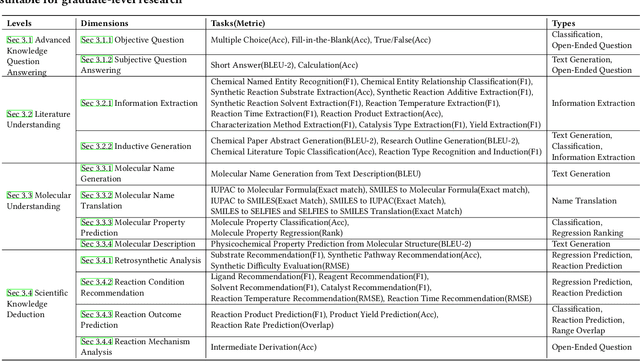
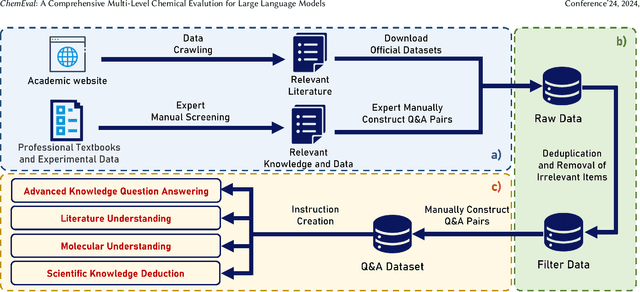


Abstract:There is a growing interest in the role that LLMs play in chemistry which lead to an increased focus on the development of LLMs benchmarks tailored to chemical domains to assess the performance of LLMs across a spectrum of chemical tasks varying in type and complexity. However, existing benchmarks in this domain fail to adequately meet the specific requirements of chemical research professionals. To this end, we propose \textbf{\textit{ChemEval}}, which provides a comprehensive assessment of the capabilities of LLMs across a wide range of chemical domain tasks. Specifically, ChemEval identified 4 crucial progressive levels in chemistry, assessing 12 dimensions of LLMs across 42 distinct chemical tasks which are informed by open-source data and the data meticulously crafted by chemical experts, ensuring that the tasks have practical value and can effectively evaluate the capabilities of LLMs. In the experiment, we evaluate 12 mainstream LLMs on ChemEval under zero-shot and few-shot learning contexts, which included carefully selected demonstration examples and carefully designed prompts. The results show that while general LLMs like GPT-4 and Claude-3.5 excel in literature understanding and instruction following, they fall short in tasks demanding advanced chemical knowledge. Conversely, specialized LLMs exhibit enhanced chemical competencies, albeit with reduced literary comprehension. This suggests that LLMs have significant potential for enhancement when tackling sophisticated tasks in the field of chemistry. We believe our work will facilitate the exploration of their potential to drive progress in chemistry. Our benchmark and analysis will be available at {\color{blue} \url{https://github.com/USTC-StarTeam/ChemEval}}.
SparkRA: A Retrieval-Augmented Knowledge Service System Based on Spark Large Language Model
Aug 13, 2024
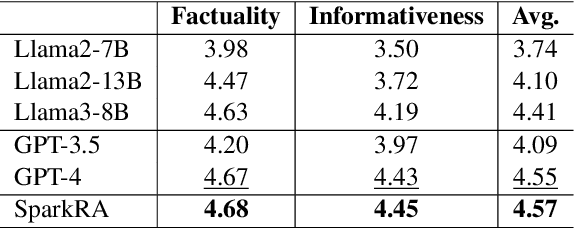

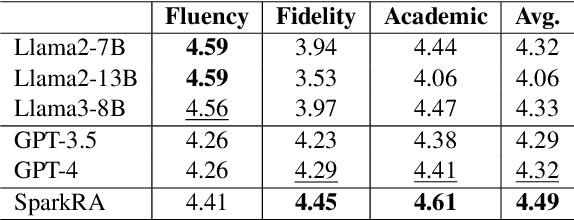
Abstract:Large language models (LLMs) have shown remarkable achievements across various language tasks.To enhance the performance of LLMs in scientific literature services, we developed the scientific literature LLM (SciLit-LLM) through pre-training and supervised fine-tuning on scientific literature, building upon the iFLYTEK Spark LLM. Furthermore, we present a knowledge service system Spark Research Assistant (SparkRA) based on our SciLit-LLM. SparkRA is accessible online and provides three primary functions: literature investigation, paper reading, and academic writing. As of July 30, 2024, SparkRA has garnered over 50,000 registered users, with a total usage count exceeding 1.3 million.
JiuZhang 2.0: A Unified Chinese Pre-trained Language Model for Multi-task Mathematical Problem Solving
Jun 19, 2023Abstract:Although pre-trained language models~(PLMs) have recently advanced the research progress in mathematical reasoning, they are not specially designed as a capable multi-task solver, suffering from high cost for multi-task deployment (\eg a model copy for a task) and inferior performance on complex mathematical problems in practical applications. To address these issues, in this paper, we propose \textbf{JiuZhang~2.0}, a unified Chinese PLM specially for multi-task mathematical problem solving. Our idea is to maintain a moderate-sized model and employ the \emph{cross-task knowledge sharing} to improve the model capacity in a multi-task setting. Specially, we construct a Mixture-of-Experts~(MoE) architecture for modeling mathematical text, so as to capture the common mathematical knowledge across tasks. For optimizing the MoE architecture, we design \emph{multi-task continual pre-training} and \emph{multi-task fine-tuning} strategies for multi-task adaptation. These training strategies can effectively decompose the knowledge from the task data and establish the cross-task sharing via expert networks. In order to further improve the general capacity of solving different complex tasks, we leverage large language models~(LLMs) as complementary models to iteratively refine the generated solution by our PLM, via in-context learning. Extensive experiments have demonstrated the effectiveness of our model.
MADNet: Maximizing Addressee Deduction Expectation for Multi-Party Conversation Generation
May 22, 2023Abstract:Modeling multi-party conversations (MPCs) with graph neural networks has been proven effective at capturing complicated and graphical information flows. However, existing methods rely heavily on the necessary addressee labels and can only be applied to an ideal setting where each utterance must be tagged with an addressee label. To study the scarcity of addressee labels which is a common issue in MPCs, we propose MADNet that maximizes addressee deduction expectation in heterogeneous graph neural networks for MPC generation. Given an MPC with a few addressee labels missing, existing methods fail to build a consecutively connected conversation graph, but only a few separate conversation fragments instead. To ensure message passing between these conversation fragments, four additional types of latent edges are designed to complete a fully-connected graph. Besides, to optimize the edge-type-dependent message passing for those utterances without addressee labels, an Expectation-Maximization-based method that iteratively generates silver addressee labels (E step), and optimizes the quality of generated responses (M step), is designed. Experimental results on two Ubuntu IRC channel benchmarks show that MADNet outperforms various baseline models on the task of MPC generation, especially under the more common and challenging setting where part of addressee labels are missing.
SHINE: Syntax-augmented Hierarchical Interactive Encoder for Zero-shot Cross-lingual Information Extraction
May 21, 2023Abstract:Zero-shot cross-lingual information extraction(IE) aims at constructing an IE model for some low-resource target languages, given annotations exclusively in some rich-resource languages. Recent studies based on language-universal features have shown their effectiveness and are attracting increasing attention. However, prior work has neither explored the potential of establishing interactions between language-universal features and contextual representations nor incorporated features that can effectively model constituent span attributes and relationships between multiple spans. In this study, a syntax-augmented hierarchical interactive encoder (SHINE) is proposed to transfer cross-lingual IE knowledge. The proposed encoder is capable of interactively capturing complementary information between features and contextual information, to derive language-agnostic representations for various IE tasks. Concretely, a multi-level interaction network is designed to hierarchically interact the complementary information to strengthen domain adaptability. Besides, in addition to the well-studied syntax features of part-of-speech and dependency relation, a new syntax feature of constituency structure is introduced to model the constituent span information which is crucial for IE. Experiments across seven languages on three IE tasks and four benchmarks verify the effectiveness and generalization ability of the proposed method.
GIFT: Graph-Induced Fine-Tuning for Multi-Party Conversation Understanding
May 17, 2023Abstract:Addressing the issues of who saying what to whom in multi-party conversations (MPCs) has recently attracted a lot of research attention. However, existing methods on MPC understanding typically embed interlocutors and utterances into sequential information flows, or utilize only the superficial of inherent graph structures in MPCs. To this end, we present a plug-and-play and lightweight method named graph-induced fine-tuning (GIFT) which can adapt various Transformer-based pre-trained language models (PLMs) for universal MPC understanding. In detail, the full and equivalent connections among utterances in regular Transformer ignore the sparse but distinctive dependency of an utterance on another in MPCs. To distinguish different relationships between utterances, four types of edges are designed to integrate graph-induced signals into attention mechanisms to refine PLMs originally designed for processing sequential texts. We evaluate GIFT by implementing it into three PLMs, and test the performance on three downstream tasks including addressee recognition, speaker identification and response selection. Experimental results show that GIFT can significantly improve the performance of three PLMs on three downstream tasks and two benchmarks with only 4 additional parameters per encoding layer, achieving new state-of-the-art performance on MPC understanding.
Multi-Stage Coarse-to-Fine Contrastive Learning for Conversation Intent Induction
Mar 09, 2023Abstract:Intent recognition is critical for task-oriented dialogue systems. However, for emerging domains and new services, it is difficult to accurately identify the key intent of a conversation due to time-consuming data annotation and comparatively poor model transferability. Therefore, the automatic induction of dialogue intention is very important for intelligent dialogue systems. This paper presents our solution to Track 2 of Intent Induction from Conversations for Task-Oriented Dialogue at the Eleventh Dialogue System Technology Challenge (DSTC11). The essence of intention clustering lies in distinguishing the representation of different dialogue utterances. The key to automatic intention induction is that, for any given set of new data, the sentence representation obtained by the model can be well distinguished from different labels. Therefore, we propose a multi-stage coarse-to-fine contrastive learning model training scheme including unsupervised contrastive learning pre-training, supervised contrastive learning pre-training, and fine-tuning with joint contrastive learning and clustering to obtain a better dialogue utterance representation model for the clustering task. In the released DSTC11 Track 2 evaluation results, our proposed system ranked first on both of the two subtasks of this Track.
SportsSum2.0: Generating High-Quality Sports News from Live Text Commentary
Oct 12, 2021

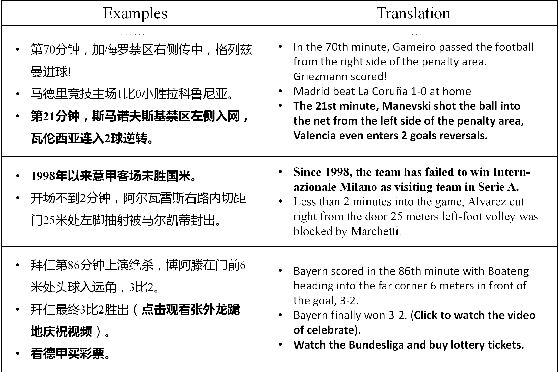

Abstract:Sports game summarization aims to generate news articles from live text commentaries. A recent state-of-the-art work, SportsSum, not only constructs a large benchmark dataset, but also proposes a two-step framework. Despite its great contributions, the work has three main drawbacks: 1) the noise existed in SportsSum dataset degrades the summarization performance; 2) the neglect of lexical overlap between news and commentaries results in low-quality pseudo-labeling algorithm; 3) the usage of directly concatenating rewritten sentences to form news limits its practicability. In this paper, we publish a new benchmark dataset SportsSum2.0, together with a modified summarization framework. In particular, to obtain a clean dataset, we employ crowd workers to manually clean the original dataset. Moreover, the degree of lexical overlap is incorporated into the generation of pseudo labels. Further, we introduce a reranker-enhanced summarizer to take into account the fluency and expressiveness of the summarized news. Extensive experiments show that our model outperforms the state-of-the-art baseline.
Adversarial Training for Machine Reading Comprehension with Virtual Embeddings
Jun 08, 2021Abstract:Adversarial training (AT) as a regularization method has proved its effectiveness on various tasks. Though there are successful applications of AT on some NLP tasks, the distinguishing characteristics of NLP tasks have not been exploited. In this paper, we aim to apply AT on machine reading comprehension (MRC) tasks. Furthermore, we adapt AT for MRC tasks by proposing a novel adversarial training method called PQAT that perturbs the embedding matrix instead of word vectors. To differentiate the roles of passages and questions, PQAT uses additional virtual P/Q-embedding matrices to gather the global perturbations of words from passages and questions separately. We test the method on a wide range of MRC tasks, including span-based extractive RC and multiple-choice RC. The results show that adversarial training is effective universally, and PQAT further improves the performance.
 Add to Chrome
Add to Chrome Add to Firefox
Add to Firefox Add to Edge
Add to Edge